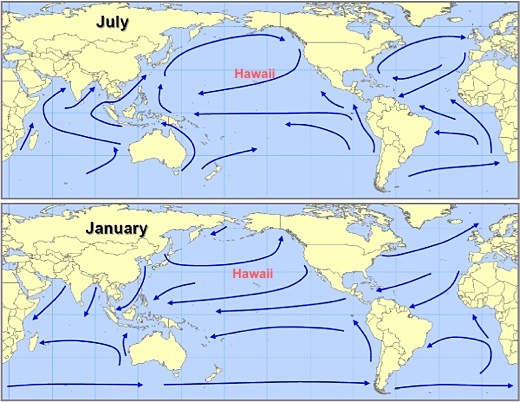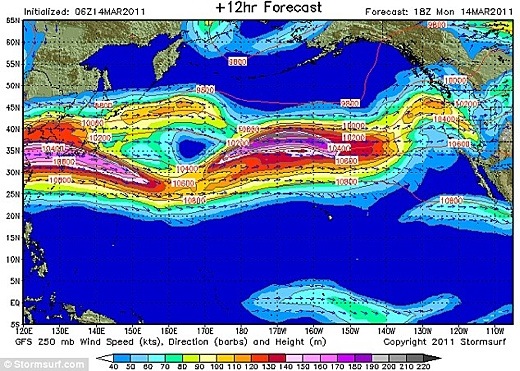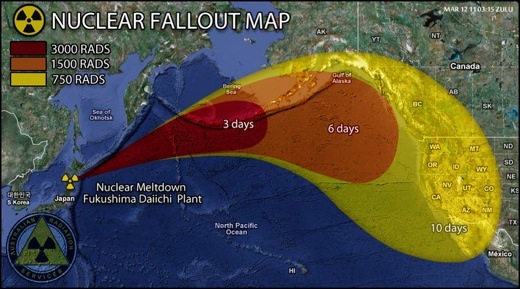SUBHEAD: What the Japanese and the world face is a long and protracted struggle to minimize the health risks posed by escaping radioactive materials from Fukushima.
By Juan Wilson on 15 March 2011 for Island Breath -
(http://islandbreath.blogspot.com/2011/03/not-chernobyl-or-china-syndrome.html)

Image above: The Fukushima nuclear power station after multiple hydrogen gas explosions. Note Reactor buildings #1 and #3 destroyed with smoke being emitted from #4. The wind blows easterly. From (http://therealtimer.com/Crisis-Deepens-at-Fukushima-Power-Plant).
Recent Events
When the earthquake hit on March 11th it was detected and the automatic systems at the Fukushima nuclear station shut down the active reactors in anticipation of structural compromise and danger of tsunami. This lessened the dangers if there was to be a failure of support systems. And there was.
Grid power and diesel auxiliary pumps have not reestablished operations. Seawater is highly corrosive, especially to electrical equipment.
By pumping ocean water into the reactors the Tokyo Electric Power Company (Tepco) has written off these nuclear reactors as forever unusable. Also in play is reactor No. 4. It was not online or fueled at the time of the earthquake.
It's fuel rods were in a cooling pool above the containment vessel. Yesterday (3/14) a fire was discovered in the cooling pool area. Fire fighters detected heightened levels of radioactivity. Japanese authorities have confirmed that the walls of the storage pool building were damaged. This may have lowered water levels and exposed the unspent fuel rods to the environment.
Long after the fire was extinguished, a Japanese official said the pool, where used nuclear fuel is kept cool, might be boiling. Japanese officials told the International Atomic Energy Agency "radioactivity is being released directly into the atmosphere."
Dangerous levels of radiation leaking from a crippled nuclear plant forced Japan to order 140,000 people to seal themselves indoors. To add to their misery, food, water and warmth are in short supply for in an area that is cold and wrecked.
Current Situation
As of today there are four atomic reactor buildings at the Fukushima nuclear facility that have been compromised. The plant operators have had over 800 workers on duty around the clock since the earthquake. Due to the current health risks associated with the radioactivity at the site, all but 50 workers have been told to evacuate.
What this possibly indicates is that not only has Tepco written off the damaged reactors, but has given up hope of bringing them safely under control. In short, it has abandoned ship.
If in fact these facilities are out of control, what are the health consequences for Japan and the world? It will likely fall in a range between what happened at Three Mile Island and what happened at Chernobyl. Already transient and anecdotal reports have measured radioactivity as high as 100 times normal around the nuclear plant.
Currently Japanese officials have announced an evacuation area with a 20 kilometer radius (12 mile) from the plant. They recommend residents inside a 30 kilometer radius (19 miles) stay indoors, seal windows and not wear clothes worn outside in their homes. Incidentally, the currently maintained Chernobyl Exclusion Zone is a 30k radius from reactor.
Worse Than Worst Case Scenario
Most experts believe it is not possible for the Japanese disaster to have the speed and intensity of radioactivity contamination as the Soviet disaster of 1986. The Chernobyl reactor did not have a suitably strong containment structure and was not water cooled.
It used graphite to cool the fuel. In Japan the explosions that damaged containment buildings were hydrogen gas explosions outside of the heavily sealed reactor vessels.
At Chernobyl the explosion was within the reactor itself (with no containment vessel) that blew the roof off the containment building and spewed a massive amount of fuel particles directly into the atmosphere. Wikipedia (http://en.wikipedia.org/wiki/Chernobyl_disaster) says:
Nature has reported that in Greece, 2,800 kilometers from Chernobyl, where radiation exposures were far lower than in areas close to the reactor, leukemia has been diagnosed at rates 2.6 times the norm in young people who were in the womb when the reactor exploded. (http://ratical.org/radiation/Chernobyl/Chernobyl@10p2.html)
What We Face
If a total meltdown of a loaded reactor vessel, or the total failure of a cooling pond with fuel rods, exposes the highly radioactive material to the outside of the plant the existing evacuation area will have to be greatly expanded. Moreover, this could lead to a release of uranium and dangerous contaminants into a widespread area causing health risks far from the plant by wind driven plumes of radioactive dust. The question is - How much, how far, for how long and where to?
As I read the situation, the next few days will determine much about the fate of nearby residents and people far off that might be exposed to health hazards as a result of the nuclear disaster in Japan. A reactor explosion is less likely now than it was, but a meltdown of the fuel through the containment vessels is possible if they cannot be cooled be seawater or re-established pumping systems.
Over time, even if exposed, the fuel in the Fukushima reactors will become less dangerous by way of atmospheric contamination. Time in years, not millennia. The site and immediate area, however, may be contaminated and pose a danger long past the lifetimes of we who witnessed this tragedy.

Image above: Seasonal winds across oceans. From (http://people.hofstra.edu/geotrans/eng/ch1en/conc1en/windpatterns.html).
Prevailing winds from Japan travel northeast towards the Aleutian Islands. In summer these winds flow east and then southeast along the Canadian coast and then south along the northwest coast of the United States. They then veer away to the southwest towards Hawaii. In the winter wind from Japan heads briefly southeast and then turns east above the 30th parallel (above Hawaii). It then heads northeast towards Alaska/Canada.

Image above: March 14th forecast of jetstream over the Pacific Ocean. From (http://www.dailymail.co.uk/news/article-1366055/Japan-earthquake-tsunami-America-nuclear-alert-Fukushima-explosion.html).
Radioactive damage to living organisms is difficult to measure. Usually doctors and scientists end up giving statistical likelihoods for contracting a specific cancer from a specific exposure. What is certain is that the Fukushima site will continue raise exposure to nuclear radiation for an extended time. The closer you are and the younger you are the worse it will be.
What We Don't Face
Certainly, the risks of nuclear power are great. I do not think the risks are worth the rewards. But fear mongering is not the right thing to do.

Image above: Prank fallout map showing lethal doses of fallout reaching California in 10 days from Japan. Do not be fooled. From (http://img847.imageshack.us/i/fallout.jpg/sr=1).
Be aware of sensationalist news stories and out-and-out fraud in reporting the dangers we face. One story in particular has gotten around to several websites. It purports to demonstrate lethal levels of radiation reaching California in ten days. Ignore such mischief.
Conclusion
It is my conclusion that here in Hawaii, at approximately 4000 miles from the danger zone, and with the prevailing winds as they are , we will be spared the brunt of any exposure.
Pray for those living inside the nightmare of the danger zone with freezing cold, no electricity, no water, little food and condemned to stay indoors with the windows sealed.
.
By Juan Wilson on 15 March 2011 for Island Breath -
(http://islandbreath.blogspot.com/2011/03/not-chernobyl-or-china-syndrome.html)

Image above: The Fukushima nuclear power station after multiple hydrogen gas explosions. Note Reactor buildings #1 and #3 destroyed with smoke being emitted from #4. The wind blows easterly. From (http://therealtimer.com/Crisis-Deepens-at-Fukushima-Power-Plant).
Recent Events
When the earthquake hit on March 11th it was detected and the automatic systems at the Fukushima nuclear station shut down the active reactors in anticipation of structural compromise and danger of tsunami. This lessened the dangers if there was to be a failure of support systems. And there was.
1) The earthquake did some structural damage to the facilities. This may have included leaks to the pools used to store and cool fuel rods in circulating water. 2) The power grid went down throughout the area, including to the pumps and other vital equipment needed to continually support safe operation of the plant (even if the reactors were shut down). Auxiliary diesel power generators kicked in. 3) The diesel generators, located in the basement areas of the plant, failed when flooded by the ensuing tsunami. Battery powered auxiliary systems kicked in. 4) Grid power was not restored. The batteries ran out. the reactor cooling systems failed. Overheated fuel rods boiled cooling water into steam and then into constituent atoms of hydrogen and oxygen. The expanding gases in the reactor cores required release from the stainless steel reactor vessels. 5) Hydrogen released into the surrounding containment building only needed a spark to explode and blow the buildings away, exposing the reactor core and cooling ponds to the environment... and there were explosions.The hydrogen explosions wrecked the No.1 (3/12) and then No. 3 (3/13) and then No. 2 (3/14) reactor containment buildings. The containment buildings of reactors No. 1 and No. 3 have experienced explosions that have blown away their upper walls and roofs exposing the interiors, including the reactor containment vessels that hold the reactors' fuel. Since the failure of conventional cooling systems, and their backups, the operators of the Fukushima reactors have been using fire trucks to pump seawater into the plants to keep them cool.
Grid power and diesel auxiliary pumps have not reestablished operations. Seawater is highly corrosive, especially to electrical equipment.
By pumping ocean water into the reactors the Tokyo Electric Power Company (Tepco) has written off these nuclear reactors as forever unusable. Also in play is reactor No. 4. It was not online or fueled at the time of the earthquake.
It's fuel rods were in a cooling pool above the containment vessel. Yesterday (3/14) a fire was discovered in the cooling pool area. Fire fighters detected heightened levels of radioactivity. Japanese authorities have confirmed that the walls of the storage pool building were damaged. This may have lowered water levels and exposed the unspent fuel rods to the environment.
Long after the fire was extinguished, a Japanese official said the pool, where used nuclear fuel is kept cool, might be boiling. Japanese officials told the International Atomic Energy Agency "radioactivity is being released directly into the atmosphere."
Dangerous levels of radiation leaking from a crippled nuclear plant forced Japan to order 140,000 people to seal themselves indoors. To add to their misery, food, water and warmth are in short supply for in an area that is cold and wrecked.
Current Situation
As of today there are four atomic reactor buildings at the Fukushima nuclear facility that have been compromised. The plant operators have had over 800 workers on duty around the clock since the earthquake. Due to the current health risks associated with the radioactivity at the site, all but 50 workers have been told to evacuate.
What this possibly indicates is that not only has Tepco written off the damaged reactors, but has given up hope of bringing them safely under control. In short, it has abandoned ship.
If in fact these facilities are out of control, what are the health consequences for Japan and the world? It will likely fall in a range between what happened at Three Mile Island and what happened at Chernobyl. Already transient and anecdotal reports have measured radioactivity as high as 100 times normal around the nuclear plant.
Currently Japanese officials have announced an evacuation area with a 20 kilometer radius (12 mile) from the plant. They recommend residents inside a 30 kilometer radius (19 miles) stay indoors, seal windows and not wear clothes worn outside in their homes. Incidentally, the currently maintained Chernobyl Exclusion Zone is a 30k radius from reactor.
Worse Than Worst Case Scenario
Most experts believe it is not possible for the Japanese disaster to have the speed and intensity of radioactivity contamination as the Soviet disaster of 1986. The Chernobyl reactor did not have a suitably strong containment structure and was not water cooled.
It used graphite to cool the fuel. In Japan the explosions that damaged containment buildings were hydrogen gas explosions outside of the heavily sealed reactor vessels.
At Chernobyl the explosion was within the reactor itself (with no containment vessel) that blew the roof off the containment building and spewed a massive amount of fuel particles directly into the atmosphere. Wikipedia (http://en.wikipedia.org/wiki/Chernobyl_disaster) says:
"The disaster began during a systems test on 26 April 1986 at reactor number four of the Chernobyl plant, which is near the town of Pripyat. There was a sudden power output surge, and when an emergency shutdown was attempted, a more extreme spike in power output occurred, which led to a reactor vessel rupture and a series of explosions. This event exposed the graphite moderator components of the reactor to air, causing them to ignite. The resulting fire sent a plume of radioactive fallout into the atmosphere and over an extensive geographical area, including Pripyat. The plume drifted over large parts of the western Soviet Union, Eastern Europe, Western Europe, and Northern Europe. Large areas in Ukraine, Belarus, and Russia had to be evacuated, and over 336,000 people were resettled. According to official post-Soviet data,[1][2] about 60% of the fallout landed in Belarus."After Chernobyl, data, based on Belarus national cancer statistics, predicts approximately 270,000 cancers and 93,000 fatal cancer cases caused by Chernobyl. The report also concludes that on the basis of demographic data, during the last 15 years, 60,000 people have additionally died in Russia because of the Chernobyl accident, and estimates of the total death toll for the Ukraine and Belarus could reach another 140,000. (http://www.greenpeace.org/international/en/news/features/chernobyl-deaths-180406)
Nature has reported that in Greece, 2,800 kilometers from Chernobyl, where radiation exposures were far lower than in areas close to the reactor, leukemia has been diagnosed at rates 2.6 times the norm in young people who were in the womb when the reactor exploded. (http://ratical.org/radiation/Chernobyl/Chernobyl@10p2.html)
What We Face
If a total meltdown of a loaded reactor vessel, or the total failure of a cooling pond with fuel rods, exposes the highly radioactive material to the outside of the plant the existing evacuation area will have to be greatly expanded. Moreover, this could lead to a release of uranium and dangerous contaminants into a widespread area causing health risks far from the plant by wind driven plumes of radioactive dust. The question is - How much, how far, for how long and where to?
As I read the situation, the next few days will determine much about the fate of nearby residents and people far off that might be exposed to health hazards as a result of the nuclear disaster in Japan. A reactor explosion is less likely now than it was, but a meltdown of the fuel through the containment vessels is possible if they cannot be cooled be seawater or re-established pumping systems.
Over time, even if exposed, the fuel in the Fukushima reactors will become less dangerous by way of atmospheric contamination. Time in years, not millennia. The site and immediate area, however, may be contaminated and pose a danger long past the lifetimes of we who witnessed this tragedy.

Image above: Seasonal winds across oceans. From (http://people.hofstra.edu/geotrans/eng/ch1en/conc1en/windpatterns.html).
Prevailing winds from Japan travel northeast towards the Aleutian Islands. In summer these winds flow east and then southeast along the Canadian coast and then south along the northwest coast of the United States. They then veer away to the southwest towards Hawaii. In the winter wind from Japan heads briefly southeast and then turns east above the 30th parallel (above Hawaii). It then heads northeast towards Alaska/Canada.

Image above: March 14th forecast of jetstream over the Pacific Ocean. From (http://www.dailymail.co.uk/news/article-1366055/Japan-earthquake-tsunami-America-nuclear-alert-Fukushima-explosion.html).
Radioactive damage to living organisms is difficult to measure. Usually doctors and scientists end up giving statistical likelihoods for contracting a specific cancer from a specific exposure. What is certain is that the Fukushima site will continue raise exposure to nuclear radiation for an extended time. The closer you are and the younger you are the worse it will be.
What We Don't Face
Certainly, the risks of nuclear power are great. I do not think the risks are worth the rewards. But fear mongering is not the right thing to do.

Image above: Prank fallout map showing lethal doses of fallout reaching California in 10 days from Japan. Do not be fooled. From (http://img847.imageshack.us/i/fallout.jpg/sr=1).
Be aware of sensationalist news stories and out-and-out fraud in reporting the dangers we face. One story in particular has gotten around to several websites. It purports to demonstrate lethal levels of radiation reaching California in ten days. Ignore such mischief.
Conclusion
It is my conclusion that here in Hawaii, at approximately 4000 miles from the danger zone, and with the prevailing winds as they are , we will be spared the brunt of any exposure.
Pray for those living inside the nightmare of the danger zone with freezing cold, no electricity, no water, little food and condemned to stay indoors with the windows sealed.
.
No comments :
Post a Comment